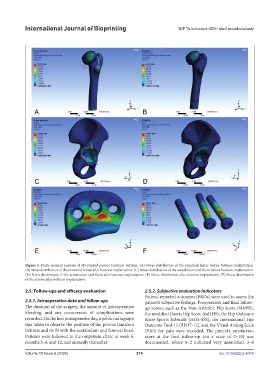Page 222 - IJB-10-6
P. 222
International Journal of Bioprinting 3DP Ta buttress in DDH shelf acetabuloplasty
Figure 3. Finite element analysis of 3D-printed porous tantalum buttress. (A) Stress distribution of the proximal femur before buttress implantation.
(B) Stress distribution of the proximal femur after buttress implantation. (C) Stress distribution of the acetabulum and ilium before buttress implantation.
(D) Stress distribution of the acetabulum and ilium after buttress implantation. (E) Stress distribution after buttress implantation. (F) Stress distribution
of the screws after buttress implantation.
2.5. Follow-ups and efficacy evaluation 2.5.2. Subjective evaluation indicators
Patient-reported outcomes (PROs) were used to assess the
2.5.1. Intraoperative data and follow-ups patient’s subjective feelings. Preoperative and final follow-
The duration of the surgery, the amount of intraoperative up scores, such as the Non-Arthritic Hip Score (NAHS),
bleeding, and any occurrences of complications were the modified Harris Hip Score (mHHS), the Hip Outcome
recorded. On the first postoperative day, a pelvic radiograph Score-Sports Subscale (HOS-SSS), the International Hip
was taken to observe the position of the porous tantalum Outcome Tool-12 (iHOT-12), and the Visual Analog Scale
buttress and its fit with the acetabulum and femoral head. (VAS) for pain were recorded. The patient’s satisfaction
Patients were followed in the outpatient clinic at week 6, score at the final follow-up (on a scale of 0–10) was
months 3, 6, and 12, and annually thereafter. documented, where 0–2 indicated very unsatisfied, 3–4
Volume 10 Issue 6 (2024) 214 doi: 10.36922/ijb.4074

